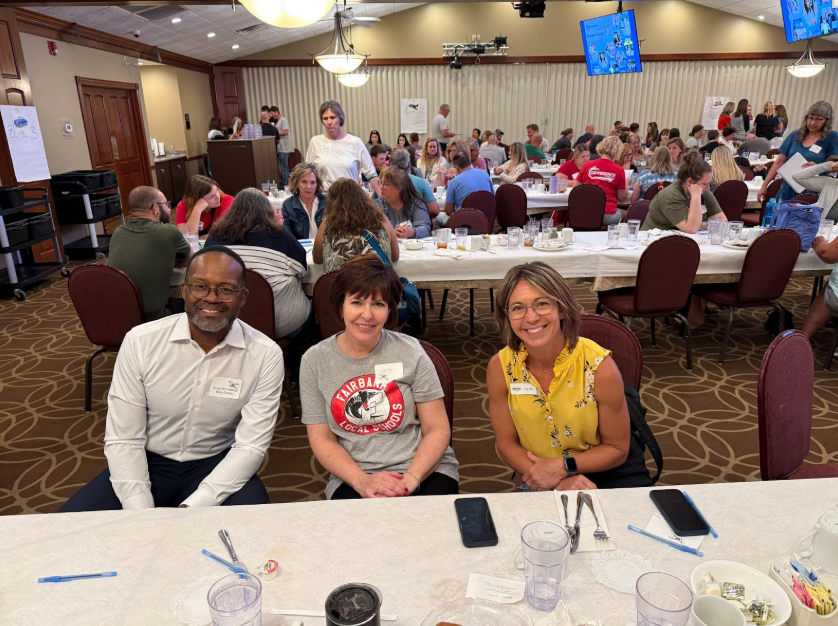Pedagogy, Meet the Portrait of a Graduate: How Authentic Learning Informed the Annual Back-to-School Convocation
- Partnerships for Authentic Learning and Leadership
- Sep 15
- 3 min read
Updated: 6 days ago
What if the annual “school year” welcome back and convocation felt like a class you never wanted to leave? This August, incoming Superintendent, Janel Chapman, Fairbanks Local Schools, wanted to inspire the school year in an innovative way. So Kristin, from the Partnerships team, and roughly 180 teachers and staff from Fairbanks, a Partnerships school, dove into a real-world design challenge in order to feel authentic learning in action, to experience the district mission, Passion in the Present, and to use the District’s Portrait of a Graduate’s future-ready skills.

Authentic learning strategies, such as design thinking, PBL, and service-learning are perfect pedagogies for ensuring Portrait of a Graduate dispositions and skills, such as kindness, problem-solving, creativity, and collaboration, are at the center of student learning experiences. And when we incorporate authentic learning into what we already do, we don’t give up the rigor that’s needed for high levels of academic achievement. We only gain it!
Read on to explore how we made this happen with our authentic design moves, a shared purpose of innovating the convocation experience, and our collaboration with the local Chamber of Commerce and business and industry partners:
Our real-world audience was DriveOhio and Beta District, both leaders in Ohio’s government and private sector (respectively) in strengthening research and innovation in mobility technologies.
Our real-world STEM focus? Mobility technologies! Think: drones, vertiports, automated trucks and cars, and high-tech safety features on busy highways.
The real-world problem? DriveOhio needs to close the gap between their mission to inform Ohioans of job opportunities in mobility technologies and the families who support their adolescent children with future thinking about careers and work.
The authentic product? A webpage concept for families on the DriveOhio site, so families are able to learn about mobility technologies and support their children with ideas for their futures. Check back in spring to see Fairbanks staffs’ webpages.
Our authentic process? Doug McCullough, Executive Director at Beta District, and Rich Granger, Managing Director Community Partnership, DriveOhio provided an entry event to jumpstart interest in the region’s mobility technologies (route 33 corridor that bisects Fairbanks Local); design thinking skills, such as collaboration and prototyping were intentional areas of focus; and, getting and using feedback on the prototypes from Beta District and DriveOhio happened before teams delivered the final pitch.
Final outcome? Fairbanks staff had a purpose that was real-world and inspiring of their engagement in learning, creativity, and problem-solving, and a real product (website concepts) was delivered to a government partner. We collaborated, communicated, engaged in a STEM design process, and reflected on the experience.
Here’s what one of the participants wrote in a final reflection of the design challenge,
“I used to think our mission statement and Portrait of a Panther were just mottos and words, but now I think they’re something we should focus on with students on every day!”

When schools align pedagogy with the Portrait of a Graduate and focus not just on content, but real-world competencies like communication, creativity, empathy, and collaboration, they deliver what everyone wants from school experiences. Families see their children thrive, Ohio gains a ready workforce, employers gain adaptable, future-ready talent, and schools achieve the measures that we currently prioritize while also tapping into student agency and interests while building future-ready competencies.
At Partnerships, we believe we should not rely on a single pedagogy to inspire all the learning that we want to see happen, and we should not rely on just the curriculum programs for all of what learning means to us in our schools today. If we align pedagogy with the Portrait of a Graduate and the skills we need for life and work today show up in every classroom. That should be our bar and that’s what we should consider measuring.

